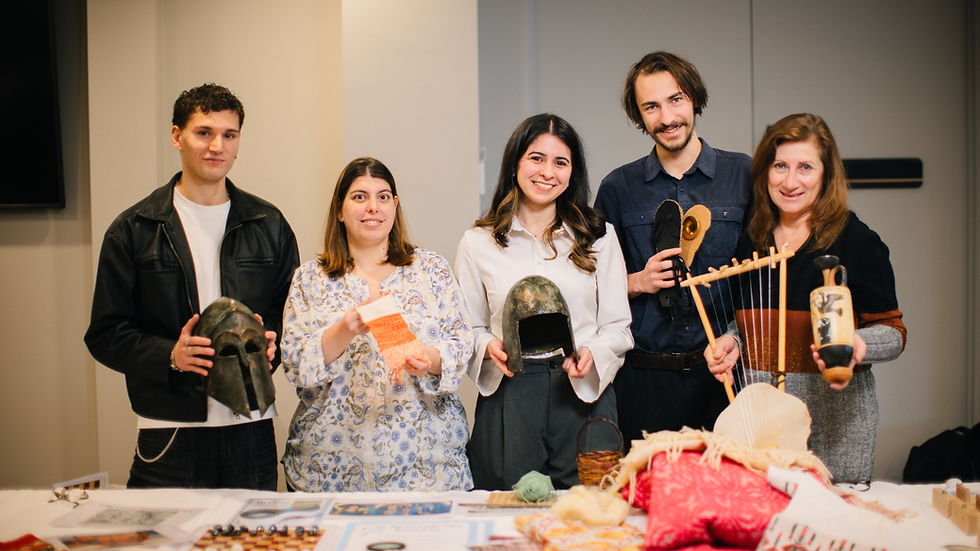In conversation with Adam Stone
- Hellenic Museum
- Oct 6, 2022
- 4 min read
Updated: Oct 10, 2022
Meet the practicing artist, founder-director of LON Gallery and curator of the new Hellenic Museum contemporary art exhibition The Sun at Midnight.

In celebration of the opening of new contemporary art exhibition The Sun at Midnight, we spoke with Adam Stone, the founder-director of Melbourne-based LON Gallery, who curated the exhibition in collaboration with the Hellenic Museum.
Housed in an intimate new gallery in the heart of the Hellenic Museum, this exhibition invites you to consider Hellenism's universality. Works from five contemporary artists – Ann Debono, Rob McLeish, Stephen Benwell, Grace Wood and Ngilan Margaret Dodd – have been curated to show that Hellenic influence can appear in unexpected places.
Viewed in isolation, many of these works may not evoke Classical influence. But place them together in the heart of the Hellenic Museum and you cannot help but observe their binding thread of Hellenic motifs and principles. Together, they create a dialogue about the ways in which Greek classicism continues to permeate and evolve in contemporary culture.
Hey Adam! Tell us a little about yourself.
I’m an artist, curator and gallerist based in Naarm/Melbourne. I graduated with a Bachelor of Fine Arts (Honours) from the Victorian College of the Arts in 2013 and have since exhibited widely in Australia and a little bit internationally. I see my curatorial practice as an extension of my own art making, where I can work collaboratively with artists to explore ideas that are beyond my capacity as an individual. It is incredibly rewarding and stimulating working with artists who have spent many years honing their skills and who are masters in their fields, to illustrate or challenge curatorial themes.
Do you have an interest in Greek art in your personal or professional practice?
During my time at the VCA I struggled immensely to find a voice for my practice. The first work I made where things clicked was when I created a two meter tall sculpture of a crashing skateboarder; which I saw as a contemporary iteration of the myth of Icarus. Since then, I have used the juxtaposition of mythology and contemporary pop culture and as strategy for making artwork.
How did you come to work with the Hellenic Museum?
I was invited by curatorial volunteer Peta, on behalf of Museum CEO Sarah Craig, to propose a series of contemporary art exhibitions which spoke to the history of Hellenic culture. Peta is a practicing artist who I had previously curated into an exhibition at LON Gallery, where she showed alongside Sydney based ceramicist, Ryan Hancock. The exhibition was titled ‘For and Against Classicism’ and was a show that explored notions of Hellenic classicism pertinent to contemporary art.
What inspired The Sun at Midnight? How did you choose the title?
The exhibition’s title speaks to the phenomenological capacity for art to function as a conduit between time, place and culture; in this case connecting two ancient civilisations, Greek and First Nations Australia with local contemporary perspectives.
How did you select the particular artists and works on display?
This was one of the trickier parts of the process. I would have liked to include another 10-15 artists in the show, but there was only space to choose five or so. With that limitation in mind, I decided to select a wide cross-section of artists whose practices addressed the curatorial theme, while at different stages of their careers, and working in different mediums. Some of the artists in the show I have worked with before, whereas others, like Stephen Benwell, are artists that I have admired for many years and haven’t had an opportunity to work with, until now.
Did you choose works that display Hellenic influence through artist intention, or has it been drawn out in the curatorial vision?
I think it was probably a mix. Grace Wood’s practice addresses elitist art histories, which encompasses the whole discourse of Western male dominated art. Similarly Rob McLeish and Ann Debono's works touch on Hellenic classicism, but although it is a recurring motif in their work, it remains more at the periphery of their personal line of enquiry. For Stephen Benwell and Ngilan Margaret Dodd, Greek culture is of profound influence. For Ngilan Margaret Dodd, all her sculptures are based on the hydria, and Stephen’s ceramic and bronze works all reference Greco-Roman statuary.
Any fun facts about the show that you’d love to share?
I was only recently introduced to Ngilan Margaret Dodd’s work. My mum saw her sculptures at Everywhen Art, which is a gallery that exhibits First Nations Australian art. When she saw that Ngilan's works fused traditional Indigenous weaving methods with the ancient form of the Greek hydria, she was really excited about the relevance to the Hellenic Museum show that she knew I was in the process of developing. Thanks for the talent scouting Mum!
What do you hope people come away with after seeing this exhibition?
I’m excited for the Hellenic Museum’s audience to have the opportunity to engage with a new range of contemporary art practices. And likewise, for the local contemporary art community to learn about the rich histories throughout the other displays on view at the Hellenic Museum. Specifically, I hope that this exhibition sheds some light on the lineage of Hellenic culture and its influence on contemporary art.
The Sun at Midnight is the first exhibition in the Hellenic Museum's new Contemporary Art Space, which will host rotating contemporary displays. So, what’s next?
I don't want to give too much away, but the next exhibition will pair sculptures by one of Australia’s leading multi disciplinary artists with artefacts from the Museum’s own collection.



